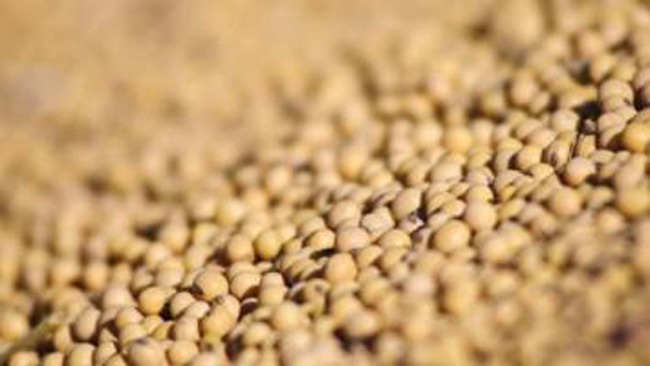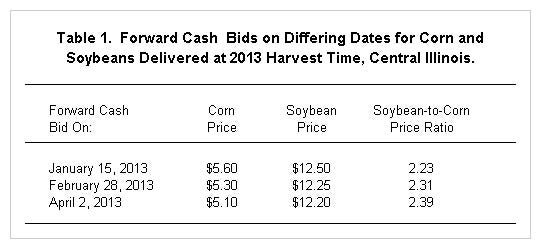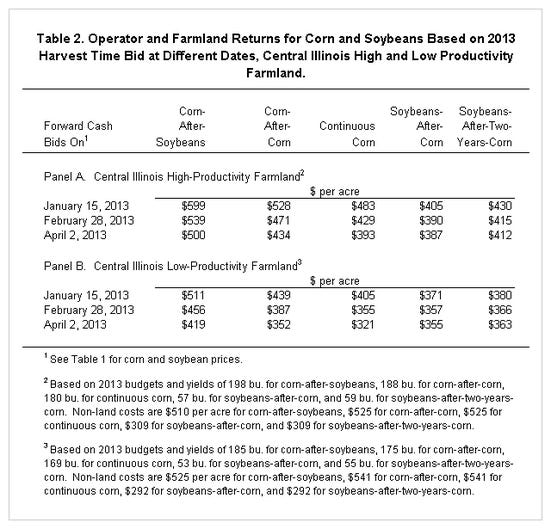April 4, 2013

USDA's March 2013 estimates of corn stocks were substantially higher than trade estimates (see here), initiating a substantial decline in both corn and soybean prices during the past week. In this article, the relative profit impacts for 2013 crops of these price changes are examined. During the first quarter of 2013, price changes have increased expected soybean returns relative to expected corn returns.
Corn and soybean price changes
Central Illinois forward cash bids for 2013 harvest time were collected on January 14, February 28th, and April 2nd (see Table 1). Note that these are forward cash bids. Since the release of USDA reports on March 28th, cash bids have declined more than harvest-time bids. For corn, cash prices fell roughly $.90 per bushel compared to roughly $.40 per bushel for harvest-time forward bids.

On January 15th, corn harvest-time bid was $5.60 per bushel and soybeans was $12.50 per bushel, giving a soybean-to-corn price ratio of 2.23. On February 28th, corn forward bid was $5.30 and soybeans was $12.25, giving a soybean-to-corn price ratio of 2.31. Between January 15th and February 28th the soybean-to-corn price ratio increased from 2.23 to 2.31, indicating the price changes increased expected soybeans returns relative to expected corn returns.
On April 2nd, corn forward bid was $5.10 per bushel and soybeans bid was $12.20 per bushel, resulting in a soybean-to-corn price ratio of 2.39. The soybean-to-corn price ratio increased from 2.31 on February 28th to 2.39 on April 2nd, again indicating that price changes increased relative expected soybean returns.
Change in expected corn and soybean returns
To quantify price change impacts on profits, returns were calculated for corn and soybean using yield and non-land costs estimates contained in the 2013 Illinois Crop Budgets for central Illinois farmland (see Handbook on Management page). Returns on both high and low productivity farmland were examined. Generally corn is relatively more profitable than soybean on higher productivity farmland because corn-to-soybean yield ratios favor corn more on higher productivity farmland.
Operator and farmland returns were calculated for five crop combinations: corn-after-soybean, corn-after-corn, continuous corn, soybeans-after-corn, and soybeans-after-two-years-corn (see Table 2). In the following, most attention will be given to a comparison of corn-after-corn to soybeans-after-corn returns, as this will likely be the choice being made this spring.

For high-productivity farmland, January 15th cash bids resulted in a $528 per acre corn-after-corn return compared to a $405 per acres soybean-after-corn return, a difference of $123 per acre in favor of corn. February 28th prices resulted in an $81 per acre difference ($471 per acre corn-after-corn - $390 per acre soybean-after-corn return). April 2nd prices resulted in a $46 per acre difference ($434 per acre corn-after-corn return = $387 per acre soybean-after-corn return). Profitability differences between the two crops substantially narrowed from $123 per acre in January 15th to $46 per acre on April 2nd.
For low-productivity farmland, January 15th harvest-time bids resulted in a $68 per acre difference in corn-after-corn and soybean returns ($68 = $439 corn-after-corn return - $371 soybean-after-corn return). This differences narrowed to $29 using February 28th bids ($29 = $387 corn-after-corn return - $357 soybean-after-corn return). Soybeans were more profitable than corn-after-corn using April 2nd prices, with a -$3 difference ($352 corn-after-corn return - $355 soybean-after-corn return). Differences changed from a $123 positive favoring corn on January 15th to a -$3 negative favoring soybeans on April 2nd.
Summary
Price changes during the first quarter of 2013 have resulted in lower expected returns for both corn and soybeans, but expected corn returns decreased more than soybean returns. On lower productivity farmland, where corn-to-soybean yield ratios are more favorable than on higher-productivity farmland, soybean-after-corn now is projected more profitable than corn-after-corn. For both high and low productivity farmland, continuous corn rotations are less profitable than corn-soybean rotations. Whether these expected return changes will impact plantings remains to be seen.
You May Also Like




